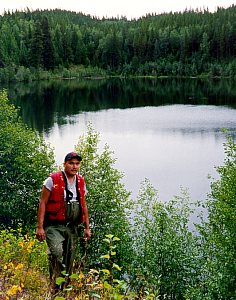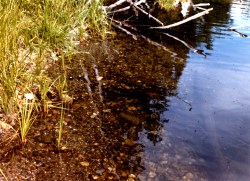 |
|||||
|
Fish & Wildlife Main Page > Lake Stock Assessment Reports > Bow Lake
Introduction
This report presents the results of a stock assessment of Bow Lake, completed on August 12, 1999 under a partnership arrangement between the Ministry of Environment, Lands and Parks and the Carrier Sekani Tribal Council (CSTC), with funding obtained from Fisheries Renewal B.C. through the Upper Fraser-Nechako Fisheries Council. Gary George and Clayton Charlie of the CSTC delivered the fieldwork component of the survey, and the author conducted the analysis and reporting of the field results. Inquiries pertaining to this report should be directed to the author at the email and address located at the bottom of this page. Bow Lake is one of five stocked lakes that are managed within Eskers Provincial Park, located 33 km northwest of Prince George. The lake was initially surveyed in 1985, and was determined to be barren of fish based on gill net and minnow trap sampling results. The lake was subsequently stocked in 1988 and 1989 with eastern brook trout fingerlings, after which stocking was ceased at the request of the Parks Branch. The cessation of stocking was brought about due to concerns regarding uncontrolled angler access to the lakes, which was occurring in response to the stocking program but in advance of the completion of adequate infrastructure to support the increased traffic. After the stocking program ceased, unconfirmed reports were submitted to Fisheries and Parks staff that some of the lakes were continuing to produce brook trout, presumably through natural recruitment. Reports were also received indicating that fish may have been transferred between lakes, a situation which, if true, would have a direct bearing on the management objectives for each of the lakes initially stocked. In 1996, Parks Branch requested that the stocking program be reinvoked, as it was felt that angler use could now be controlled given the state of the park's infrastructure. The lake was accordingly stocked in 1997 at an alternate-year stocking frequency. Since no additional assessments had been performed on Bow Lake since stocking was initiated in the late 1980s, and since the renewed stocking program had been in effect for two years, Bow Lake was assigned a high priority for assessment in 1999.
Methods
A 91.4 m sinking monofilament gill net with experimental mesh sizes was set in Bow Lake on August 11, 1999, according to the methods specified in the Resource Inventory Committee document Fish Collection Methods and Standards. The net was deployed at 3:19 PM and retrieved August 12 at 11:30 AM, for a total soak time of 20.2 hours. The net was set from the northeast shore of the lake, and extended in a SSW orientation. The net ranged in depth from the surface to approximately 3.5 m. (Figure 1). All trout collected were sampled for fork length, weight, sex, and maturity. Weight was measured to the nearest 10 g. Scale samples were collected for ageing, which was performed by Darlene Gillespie of TimeMark Consulting Ltd. (Nanaimo, B.C.).
Results and Discussion
CATCH SUMMARY The net catch yielded 80 eastern brook trout (EB), for a catch per unit effort (CPUE) of 4.0 EB per net-hour. See Appendix 1 for specific fish attribute data. Due to a first aid emergency, the field crew was only able to sample 36 of the captured fish. Whether the fish sampled were collected randomly from all net panels is unknown, hence the survey results may be skewed due to selection bias.
The sex ratio of the sample was 16 females : 19 males, with 1 unknown. The sampled population was roughly split between maturing or mature, and immature fish (Figure 2), with only 1 fish classified as "unknown". One brook trout was classified as "eggbound", and one was "spent", indicating that spawning activity was taking place during the time of survey. Since 1997, Bow Lake has received triploid brook trout, which remain permanently immature throughout their life cycle so as to prevent natural recruitment of this introduced species. The presence of mature fish in the sample suggests that the brook trout population is being propagated by progeny of the stock released in the late 1980s. CONDITION Bow Lake brook trout are reported as having a low mean condition factor with a high variance (Table 2), and 8 and 25 fish have a reported condition factor of less than 0.5 and 1.0 respectively. Generally the mean condition of brook trout sampled in the Omineca region is above 1.0 (see Shere Lake, and Cobb Lake for examples), and the variance is less than what is reported for Bow Lake. It is therefore likely that during this survey the level of precision applied to the weighing procedure was low, or that the weighing apparatus was not correctly calibrated prior to conducting the assessment. This is supported by the fact that the field crew that conducted this survey also reported highly variable weight data for Byers Lake and Butterfly Lake. LENGTH FREQUENCY DISTRIBUTION
Since the catch was not completely sampled, and since there is no indication that the sub-sample was randomly selected, the length frequency distribution reported here cannot be said to represent the population as a whole. Nonetheless, the distribution (Figure 3) of the catch indicates the presence of at least 4 and possibly 5 age classes of brook trout in Bow Lake. Since the fry released in 1997 and 1999 are triploid, or 100% immature, it can be assumed that the larger mature and maturing brook trout do not represent recent hatchery stock. According to the age results, the 260 to 320 mm size range represents primarily age 3 fish (see below). However, since scales were collected for age analysis (which are considered less preferable than fin rays), the ageing contractor did not express a high degree of confidence in the age results, and this distribution may therefore represent both age 2 and age 3 individuals. While the weight of any particular size class in the sample may not accurately reflect the proportion of that class in the population, the data does show that the population is distributed over a wide range of size classes. This suggests that naturalized brook trout have become well established in Bow Lake, and that they are contributing strong year classes to the population.
GROWTH As stated previously, the growth data presented here represents a 'best guess' approach due to difficulties that were encountered in analyzing the age structures. Ages have been adjusted, where the ageing contractor has provided more than one possible age, to fit within a plausible growth pattern for Bow Lake brook trout. The growth rate of Bow Lake trout is similar to, and less variable, than that reported for Butterfly Lake. The occurrence of a distinct cluster of fish in the 260 - 320 mm size range (see above), coupled with the apparent slow growth of 3-year-old fish (Figure 4), suggests that some age 2 fish may have been incorrectly classified as age 3. At current growth rates, it appears that Bow Lake brook trout recruit into the recreational fishery by the end of their third growing season (i.e. age 2+), assuming that anglers target a minimum size of 250 mm. However, while a detailed cohort analysis cannot be performed on this data set (see Butterfly Lake for an example), it is likely that the naturalized spawning population has increased in size over the last five years. If this is the case, an increase in the number of annual recruits can be expected until the amount of available spawning habitat has been saturated and recruitment has reached its maximum. This production increase will be mirrored by a decrease in annual growth, and the quality of the fishery (in terms of mean size-at-age) will diminish. This situation will be compounded by the release of additional hatchery fry, as both stocks compete for finite resources.
Management Recommendations Bow Lake appears to support a naturalized stock of eastern brook trout. Since the Province has adopted a policy of stocking exclusively non-reproductive brook trout, the existence of a viable population in Bow Lake should be afforded special attention. Additional investigation into the factors contributing to successful recruitment is warranted, such as a spawning survey to determine how the present population is sustaining itself. Philip (1985) noted that the presence of clean gravel substrate on the west shoreline might indicate the presence of springs (PHOTO 2), which could provide sufficient spawning habitat for the resident trout. Once the capability of the lake to generate recruits has been established, a careful review of the risks associated with maintaining naturalized stocks should then be undertaken.
The increase in natural production observed in Bow Lake is likely to result in a reduction in growth, due to density dependent factors, and it is predicted that this reduction will be further magnified by the release of hatchery stock. It is therefore recommended that the Bow Lake stocking program be immediately suspended until such time as fisheries managers evaluate the effect of stock supplementation on the naturalized population. The recommended approach to achieving this objective is to develop a paired lake study, whereby the performance of the Butterfly Lake supplemented fishery would be compared against the 'standalone' fishery in Bow Lake. This study will provide insight into the relative performance and contribution of naturalized and hatchery stocks to the recreational fishery. Since each lake received hatchery releases in 1997 and 1999, it is recommended that the proposed study be delayed until 2003 or later, in order to provide enough time for each lake's population to reach equilibrium.
Literature Cited. Philip, D.F. 1985. A Reconnaissance Survey of Bow Lake.
Report prepared for the Fisheries Branch, Ministry of Environment.
Prince George.
For More Information: Contact :Ted Zimmerman
|
||||||||||||||||||||||||||||||||||||||||||||||||||||||||||||||||||||





